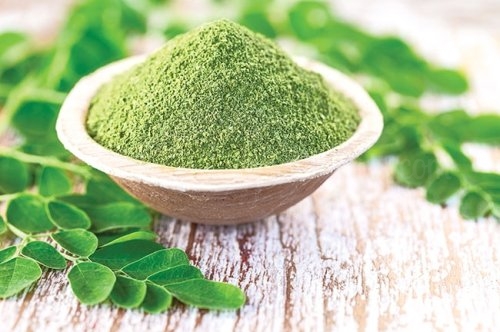
What is Curry Leaves?
Curry leaves are small in size and long, slender, and oval in shape narrowing to a point, averaging 2-4 centimeters in length and 1-2 centimeters in width. The shiny, dark green leaves grow pinnately along a stem, and each branch can hold up to twenty, tightly clustered leaves. Curry leaves are extremely aromatic and have a strong flavor that has been compared to citrus, asafoetida, anise, and lemongrass. When cooked, Curry leaves have a mild and slightly pungent bite with a nutty aroma.
The curry tree, a unique citrus tree native to regions of India and Sri Lanka, has become almost synonymous with Indian cuisine. As a member of the citrus family, curry leaves have a strong, fragrant flavor similar to lemongrass. There are three types of curry leaf trees: regular, dwarf, and gamthi. The regular type grows fast and is tall. The leaves from this plant are commonly sold in grocery stores.
Used as an herb, curry leaves pack a much subtler flavor than curry powder by lending a complex depth of flavor to any dish. When cooked into a dish, curry leaves enhance the other flavors, giving Indian food its fragrant, robust flavors. Curry leaves have a somewhat sweet taste, earning them the nickname sweet neem leaves. There are different ways use curry leaves,
- As Curry Leaves
- As Curry Leaves Powder
- As Curry Leaves Oil
How to growing Curry Leaves?
Curry leaf plants may be grown from cuttings or seed. The seed is the pit of the fruit and can either be cleaned or the entire fruit may be sown. Fresh seed shows the greatest rate of germination. Sow the seeds in potting soil and keep them damp but not wet.
They will need a warm area of at least 68 degrees Fahrenheit (20 C.) to germinate. Growing curry leaf tree from seed is not an easy task because germination is fickle. Other methods are more consistent. Potted Bulbs 0 seconds of 1 minute, 29 secondsVolume 0% Next Stay You can also use fresh curry leaves with petiole or stem and start a plant. Treat the leaves as a cutting and insert them into a soilless potting medium. Take a piece of stem from the tree that is about 3 inches (7.5 cm.) long and has several leaves. Remove the bottom 1 inch (2.5 cm.) of leaves. Immerse the bare stem into the medium and mist thoroughly. It will root in about three weeks if you keep it warm and moist.
Growing curry leaves to produce a new plant is the easiest method of propagation. Growing curry leaf tree in the home garden is only advisable in areas without freezes. Curry leaf plant is frost tender but it can be grown indoors. Plant the tree in a well-drained pot with a good potting mix and place it in a sunny area. Feed it weekly with a diluted solution of seaweed fertilizer and trim the leaves as needed.
Watch the plant for mites and scale. Use an insecticidal soap to combat the pests. Curry leaf requires moderately moist soil. Curry leaf care is quite straightforward and even suitable for a beginner.
Climate for growing Curry Leaves
A curry plant can be grown practically during any time of the year. But the best time to plant it is before the monsoon or winter season,” “The curry plant is sensitive to extreme heat and may not attain a maximum growth during the period.
The curry leaf plant will not do well at all, in temperatures that drop below 40 degrees Fahrenheit. In general, you'll want to keep the air in the growing environment around 65 degrees Fahrenheit or warmer.
Curry Leaves Harvesting
Wait until your plant is at least 1-2 years old before taking any leaves. New curry leaf plants don’t have enough leaves to harvest and continue growing while they’re young, so wait until your plant is at least 1 year old. If you plant is still thin or only has a few stems with leaves on them after a year, let it keep growing until it’s filled out.
If you planted your curry leaf plant from a cutting, then it may be full enough after a few months to harvest some of the leaves.
Pull the base of the leaf stem from the plant when you’re ready to harvest. Don’t pull off the leaves individually since it leaves a lot of empty growth on the plant. Instead, look where the long stem that connects multiple leaves attaches to the main body of the plant. Grip the stem by its base and lightly pull it off the plant to collect all of the leaves attached to it.
Only harvest what you immediately need so the plant can continue growing.
You can harvest up to 30% of the plant’s leaves. If you harvest more, the plant may not grow as well the following year.
Uses of Curry Leaves
Curry leaves are the foliage of the curry tree (Murraya koenigii). This tree is native to India, and its leaves are used for both medicinal and culinary applications. They’re highly aromatic and have a unique flavor with notes of citrus. Curry Leaves mostly used for flavor curries. In addition curry leaves used for as medicine, make oils & beauty products, cooking variety foods & juices.
Nutrition in Curry Leaves
Curry leaves are an excellent source of the following nutrients:
- Vitamin C
- Vitamin A
- Vitamin E
- Vitamin B
Benefits of Curry Leaves
More than acting as a flavorful herb in Asian cooking, curry leaves have a number of health benefits. In fact, they’re commonly used in Ayurvedic medicine.
- Weight loss.
- It can help in treating dysentery, constipation and diarrhea.
- Relieves morning sickness and nausea.
- Eliminates bacteria.
- Good for diabetics.
- Good for eyesight.
- Reduce stress.
- Heals wounds, burns and skin eruptions.
- Hair growth.
- Improves memory.
- Breast cancer.
 English
English
 Russian
Russian  Arabic
Arabic  French
French  Español
Español  Turkish
Turkish  German
German 







